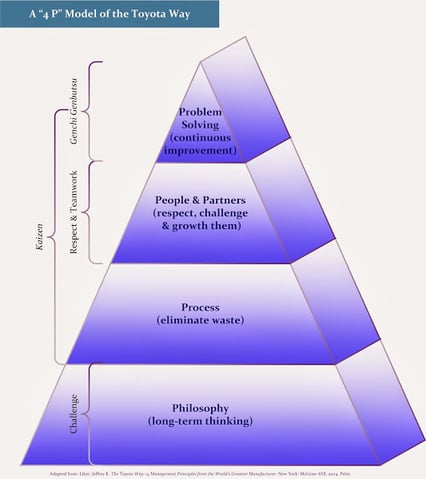When Jeffrey K. Liker published The Toyota Way* in 2004, he said, “I have visited hundreds of organizations that claim to be advanced practitioners of lean methods. They proudly show off their pet lean project. And they have done good work, no doubt.”
But, “[t]he problem is,” Liker goes on to say, “that companies have mistaken a particular set of lean tools for deep ‘lean thinking.’”
What Liker expressed in 2004 about individual firms is equally true about most so-called “lean supply chains” today.
Most “lean” companies (in 2004) were stuck on the “Process” level in the 4-P model of the Toyota Way shown here. Today, for those companies working on implementing “lean supply chains,” they, too, are stuck on “Process.” And a great many of them are still stuck primarily on internal processes.

For all the talk about “collaborative supply chains,” there has been very little real movement toward “Respect and Teamwork”—the “People and Partners” level in the Toyota Way.
Most supply chain relationships amongst small to mid-sized business enterprises today are still arms’-length agreements between two parties that know little about one another’s operations and, sadly, they are happy to have it that way.
We Call it a “Supply Chain” for a Reason
Apparently, for a great many executives and managers, the term “supply chain” has not really sunk in, yet. They think of the SUPPLY side of the transaction without considering the CHAIN side.

Anyone who has ever worked with a chain knows that, if a chain is going to fail to fulfill what is being asked of it, it’s going to fail—by definition—at its weakest link.
It is the weakest link that defines the very limit to which a chain will be reliable. Yet, a great many executives and managers involved in supply chain management do not know where the weakest link in their supply chain is—literally.
They don’t know the geographical locations involved in the flow of materials from raw materials (e.g., mined, harvested, reclaimed) to their receiving dock. Most can only guess whether a disruption in the shipping lanes in some part of the world might have an effect on supply of a product to their firm. And, if they do know, it is probably because they have already experienced a disruption in their supply chain and were forced to discover the cause.
Everybody’s Throughput is Limited by the Weakest Link
Because every participant’s Throughput is limited by the ability of the weakest link in the supply chain, it is in every manager and executive who is involved in supply chain management to know and understand these factors:
- Where is the weakest link in my supply chain? Where is it geographically?
- What company in my supply chain is responsible for the weakest link?
- Who is responsible for the weakest link? Meet the managers and executives in the firm involved. Get to know them so that you can have an open dialog with them about how you can help them strengthen this weakest link.
- When is the weakest link the most vulnerable to failure? How can managing the supply chain on your end help minimize negative impacts on the weakest link?
- Why is this the weakest link? What are the weaknesses? How can the limited Throughput of the weakest link be improved?
As long supply chain managers and executives busy themselves around “processes” with an internal focus, supply chains in most small to midsized companies will remain vulnerable to the weakest link in their supply chains.
Real improvement to supply chains comes from getting outside the four walls of your enterprise and working with supply chain partners—especially the present “weakest link”—respectfully challenging them and helping them grow.
Such an approach will strengthen the weakest link and increase Throughput and profitability for all of the participants in the supply chain. This is a real win-win!
We would be delighted to hear from you on this topic. We are being called upon more and more to help companies improve the approach to supply chain management. Leave your comments here, or feel free to contact us directly.
* Liker, Jeffrey K. The Toyota Way: 14 Management Principles from the World's Greatest Manufacturer. New York: McGraw-Hill, 2004. Print.



